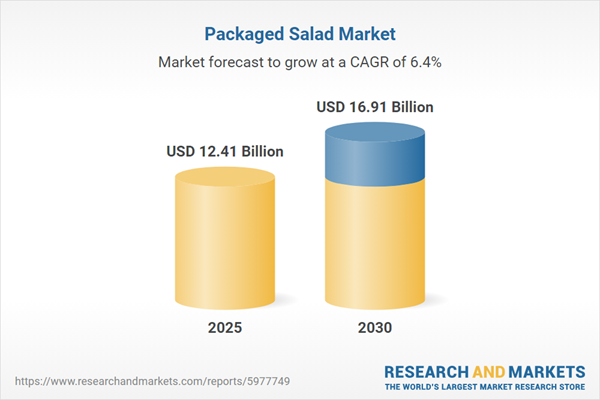Speak directly to the analyst to clarify any post sales queries you may have.
The packaged salad market is evolving rapidly as health-conscious consumers and industry innovators reshape how fresh produce is grown, processed, and delivered. Senior decision-makers are navigating an environment defined by shifting preferences, upgraded supply chains, and regulatory complexity to drive growth and competitive advantage in this dynamic sector.
Market Snapshot: Packaged Salad Market Overview
Fueled by increasing demand for convenience and wellness, the packaged salad market grew from USD 11.63 billion in 2024 to USD 12.41 billion in 2025. With a projected CAGR of 6.60%, the market is expected to reach USD 19.39 billion by 2032. This robust expansion reflects growing interest in ready-to-eat, nutrient-dense food options, strategic investments in cold chain logistics, and innovative packaging technologies that extend product shelf life and improve efficiency throughout value chains.
Scope & Segmentation
This analysis offers a detailed examination of the packaged salad market landscape, segmented across product types, user profiles, packaging technologies, and geographic regions. Strategic relevance is explored for each group, providing actionable clarity for competitive positioning.
- Source Types: Conventional, Organic
- Distribution Channels: Convenience Stores, Online Retailers, Supermarkets and Hypermarkets
- End Users: Foodservice, Residential
- Packaging Formats: Bag, Bowl, Clamshell
- Product Categories: Herbs (Basil, Cilantro, Parsley), Leafy Greens (Kale, Lettuce, Spinach), Microgreens (Broccoli, Radish, Sunflower), Mixed Greens (Mesclun, Spinach Mix, Spring Mix), Sprouts (Alfalfa, Bean Sprouts)
- Regions: Americas (including United States, Canada, Mexico, Brazil, Argentina, Chile, Colombia, Peru), Europe, Middle East & Africa (with sub-segments like United Kingdom, Germany, France, United Arab Emirates, South Africa, Nigeria), and Asia-Pacific (China, India, Japan, Australia, South Korea, Indonesia, Thailand, Malaysia, Singapore, Taiwan)
- Leading Companies: Fresh Express, Dole Food Company, Fresh Del Monte Produce, Taylor Farms, Ready Pac Foods, Earthbound Farm, Fresh Gourmet, Mann Packing, Tanimura & Antle, Bonduelle SCA
Key Takeaways for Senior Decision-Makers
- Consumer shifts toward health and convenience are redefining the competitive landscape, with premium organic and niche blends gaining traction among discerning buyers.
- Technology implementation—from automated quality control to digital supply chain monitoring—strengthens scalability, enhances transparency, and tunes inventory to demand.
- Sustainability is becoming fundamental, as market leaders trial recyclable packaging, water-efficient cultivation, and circular economy models to align with evolving environmental expectations.
- Retail innovation such as refillable salad stations and digital ordering empower personalized experiences and recurring revenue streams, especially in high-growth e-commerce channels.
- Collaborative partnerships between growers, processors, and retailers facilitate seamless logistics, bolster food safety, and support timely product innovation.
- Regional differentiation is critical for success as local regulations and consumer behaviors drive tailored product development, marketing initiatives, and supply chain configurations.
Tariff Impact on Strategic Planning
Recent and upcoming tariffs in the United States are altering cost structures for both raw ingredients and packaging materials in the packaged salad industry. These measures prompt businesses to reassess sourcing strategies, seek alternative suppliers, and negotiate long-term contracts to minimize volatility. Companies with flexible packaging processes are trialing bio-based alternatives to reduce tariff exposure, while some exporters turn to tariff-exempt zones and free trade agreements for cost optimization. These responses enhance supply chain resilience and sustain competitive pricing in challenging regulatory contexts.
Methodology & Data Sources
This research integrates insights from direct interviews with senior executives in cultivation, processing, and retail. Extensive secondary review of industry reports complements these findings. Rigorous data triangulation and modeling validate projections and ensure robust, actionable intelligence.
The Packaged Salad Market: Why This Report Matters
- Enables market leaders to identify emerging growth drivers, respond quickly to evolving consumer demands, and strengthen supplier relationships.
- Delivers strategic guidance on risk mitigation, compliance, and innovation initiatives to accelerate market share and operational efficiency gains.
- Empowers stakeholders to design customized offerings and leverage sustainability practices as actionable competitive differentiators.
Conclusion
The packaged salad market is shaped by dynamic preferences and ongoing innovation. This report equips industry leaders with the insights needed to refine strategy, sustain resilience, and capitalize on new opportunities in a continuously evolving market landscape.
Additional Product Information:
- Purchase of this report includes 1 year online access with quarterly updates.
- This report can be updated on request. Please contact our Customer Experience team using the Ask a Question widget on our website.
Table of Contents
3. Executive Summary
4. Market Overview
7. Cumulative Impact of Artificial Intelligence 2025
Companies Mentioned
The companies profiled in this Packaged Salad market report include:- Fresh Express, Inc.
- Dole Food Company, Inc.
- Fresh Del Monte Produce Inc.
- Taylor Farms, Inc.
- Ready Pac Foods, LLC
- Earthbound Farm, Inc.
- Fresh Gourmet, LLC
- Mann Packing Co., Inc.
- Tanimura & Antle, Inc.
- Bonduelle SCA
Table Information
| Report Attribute | Details |
|---|---|
| No. of Pages | 199 |
| Published | October 2025 |
| Forecast Period | 2025 - 2032 |
| Estimated Market Value ( USD | $ 12.41 Billion |
| Forecasted Market Value ( USD | $ 19.39 Billion |
| Compound Annual Growth Rate | 6.6% |
| Regions Covered | Global |
| No. of Companies Mentioned | 11 |









